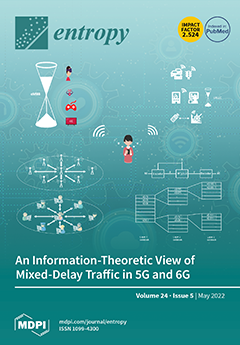Open AccessFeature PaperArticle
Information Dynamics of Electric Field Intensity before and during the COVID-19 Pandemic
by
Gorana Mijatovic, Dragan Kljajic, Karolina Kasas-Lazetic, Miodrag Milutinov, Salvatore Stivala, Alessandro Busacca, Alfonso Carmelo Cino, Sebastiano Stramaglia and Luca Faes
Cited by 1 | Viewed by 1592
Abstract
This work investigates the temporal statistical structure of time series of electric field (EF) intensity recorded with the aim of exploring the dynamical patterns associated with periods with different human activity in urban areas. The analyzed time series were obtained from a sensor
[...] Read more.
This work investigates the temporal statistical structure of time series of electric field (EF) intensity recorded with the aim of exploring the dynamical patterns associated with periods with different human activity in urban areas. The analyzed time series were obtained from a sensor of the EMF RATEL monitoring system installed in the campus area of the University of Novi Sad, Serbia. The sensor performs wideband cumulative EF intensity monitoring of all active commercial EF sources, thus including those linked to human utilization of wireless communication systems. Monitoring was performed continuously during the years 2019 and 2020, allowing us to investigate the effects on the patterns of EF intensity of varying conditions of human mobility, including regular teaching and exam activity within the campus, as well as limitations to mobility related to the COVID-19 pandemic. Time series analysis was performed using both simple statistics (mean and variance) and combining the information-theoretic measure of information storage (IS) with the method of surrogate data to quantify the regularity of EF dynamic patterns and detect the presence of nonlinear dynamics. Moreover, to assess the possible coexistence of dynamic behaviors across multiple temporal scales, IS analysis was performed over consecutive observation windows lasting one day, week, month, and year, respectively coarse grained at time scales of 6 min, 30 min, 2 h, and 1 day. Our results document that the EF intensity patterns of variability are modulated by the movement of people at daily, weekly, and monthly scales, and are blunted during periods of restricted mobility related to the COVID-19 pandemic. Mobility restrictions also affected significantly the regularity of the EF intensity time series, resulting in lower values of IS observed simultaneously with a loss of nonlinear dynamics. Thus, our analysis can be useful to investigate changes in the global patterns of human mobility both during pandemics or other types of events, and from this perspective may serve to implement strategies for safety assessment and for optimizing the design of networks of EF sensors.
Full article
►▼
Show Figures






